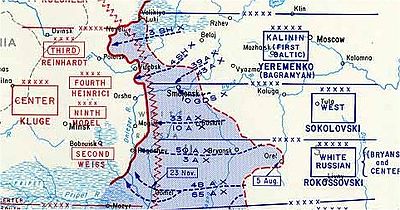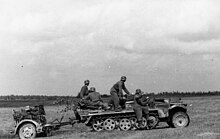Smolensk operation
1941: Białystok-Minsk - Dubno-Lutsk-Rivne - Smolensk - Uman - Kiev - Odessa - Leningrad blockade - Vyazma-Bryansk - Kharkov - Rostov - Moscow - Tula
1942: Rzhev - Kharkiv - Company Blue - companies Braunschweig - company Edelweiss - Stalingrad - Operation Mars
1943: Voronezh-Kharkov - Operation Iskra - North Caucasus - Kharkov - Citadel Company - Oryol - Donets-Mius - Donbass - Belgorod-Kharkov - Smolensk - Dnepr
1944: Dnepr-Carpathians - Leningrad-Novgorod - Crimea - Vyborg-Petrozavodsk - Operation Bagration - Lviv-Sandomierz - Jassy-Kishinew - Belgrade - Petsamo-Kirkenes - Baltic States - Carpathians - Hungary
1945: Courland - Vistula-Oder - East Prussia - West Carpathians - Lower Silesia - East Pomerania - Lake Balaton - Upper Silesia - Vienna - Oder - Berlin - Prague
The Smolensk Operation (also known as Operation Suvorov ; Russian Смоленская операция ) was a major offensive by the Red Army during World War II that lasted from August 7 to October 2, 1943. In the course of this operation, four sub-operations were carried out, which Russian military historians refer to as the Spas-Demensk Operation , Yelnya -Dorogobush Operation , Duchovshchina-Demidov Operation and Smolensk-Roslavler Operation .
Troop strength
The Western Front under Sokolowski , together with the left flank of the Kalinin Front under Jerjomenko, had 1.253 million soldiers, 20,640 guns, 1,436 tanks and 1,000 aircraft. The German Army Group Center under General Field Marshal von Kluge had around 850,000 soldiers, 8,800 artillery pieces, 500 tanks and up to 700 aircraft (3rd Panzer Army, 4th Army and parts of 9th Army) at their disposal. The 100–130 kilometers deep German defense was built on difficult terrain with numerous forests, lakes and swamps.
course
Attacks at Spas-Demensk and Kirov
On August 7th, the 10th Guard Army (General KP Trubnikow ), the 33rd and 49th Armies ( Major General IT Grischin ) attacked the western front and threatened to encircle the German group at Spas-Demensk , which is why the German 4th Army (Colonel General Heinrici ) began to withdraw in an orderly fashion. At the German XII. Army Corps (General of the Infantry von Tippelskirch ) were initially able to repel new attacks by the 49th Army against Spas-Demensk. The LVI stopped in the Kirov area . Panzer Corps at Pesochnja connection to the LV. Army Corps of the 2nd Panzer Army ( AOK withdrawn on August 18, then the command area of the 9th Army ). General Hoßbach's group was concentrated west of the Bolwa river : in the south the 321st Infantry Division held positions on the west bank of the river opposite Kirov, in the west and north of the frontal promontory the 131st and 14th Infantry Divisions held positions opposite the Soviet 10th. Army . The main battle for possession of the Roslavl - Juchnow runway took place between Bolshukha and Alexsandrovskoye, and the worn-out 9th Panzer Division was brought in from the reserve on the northern wing . In addition, the 5th and 20th Panzer Divisions, weakened in their combat strength, were used to help the southern section, which was harassed by the Soviet 10th Army and 5th Mechanical Corps (General MW Volkov ). On August 13th, Spas-Demensk was liberated by the 49th Army in cooperation with the 33rd Army (General WN Gordow ) and the 2nd Guard Panzer Corps (Major General AS Burdenji ), which advanced about 10 kilometers by August 20 and then went over to the defense at Desna .
On August 13, the left wing of the Kalinin Front attacked ( the 39th Army under General AI Sygin and 43 Army under General KD Golubev ) and the right wing of the Western Front ( 31 Army under Lieutenant General W. A. Gluszdowski ) towards Duchowschtschina on. The attack was canceled on August 17, because counter-attacks began and the defense lines of the German XXVII. Army corps could not be overcome.
Jelnya-Dorogobush operation
On August 18, after the departure of the 2nd Panzer Army, the section boundary between the German 9th and 4th Armies changed, the road between Roslavl and Juchnow formed the new border, with the LVI in addition. Panzer Corps changed to the command area of the 9th Army. Colonel-General Model switched between the LV corps commands because of the threat of the intervention of the Brjansk Front (Colonel-General MM Popow ) from Smolensk to Roslavl. and LVI. the XXXXI. Panzer Corps . On August 27, the LVI. Panzer Corps was detached from the front and replaced by the XXXXI corps command. (General der Panzertruppe Harpe ), which had to protect the threatened Smolensk area.
On August 28, the Soviet troops achieved another breakthrough, which the Wehrmacht tried in vain to close with counter-attacks. In the section of the German IX. Army Corps (General of the Infantry Schmidt ) was liberated on August 30, Jelnja by the Soviet 33rd Army and on September 1, Dorogobusch was liberated by the Soviet 5th Army (Major General WS Polenov ). On September 6, an infantry division and an SS brigade from the reserve were called in, which were initially able to contain the further advance of the Soviet troops.
Dukhovshchina-Demidov operation
After the regrouping of the Soviet troops, they opened on 14./15. September a new phase of attack, which also affected the right wing of the German 3rd Panzer Army . On September 14, troops from the Kalinin Front opened the attack on Demidov and Duchowschtschina . The main attack led the 39th Army (now under Lieutenant General NJ Bersarin ) and the left wing of the 43rd Army (Lieutenant General KD Golubjew) with a total of 12 rifle divisions, plus the 5th Guards Rifle Corps from the reserve. Troops of the right wing of the Western Front (31st, 5th and 68th Armies) tried to break into the German positions in the Jarzewo area, the plan was to join the left wing of the Kalinin Front after crossing the rivers Vop and Dnieper. By the end of the day, the German positions could be indented between 3 and 13 kilometers to a width of 30 kilometers. After 4 days of fighting, the defense of the German VI. and XXVII. Army corps completely broken. On the night of September 19, the 39th Army penetrated Duchovshchina after supporting the 3rd Air Army (Lieutenant General NF Papiwin ). The 43rd Army moved into Demidow on September 22nd after two days of fighting with the 91st Rifle Corps (Major General FA Volkov ) .
Smolensk-Roslavler Operation
On September 15, the line of defense of the German 4th Army was breached almost everywhere, the Soviet troops were supported by partisans operating in the hinterland. The main attacks on the western front were now set up by the 10th Guard, 21st and 33rd Armies via Pochinok on Orsha . The armies of the right wing (31st, 5th and newly introduced 68th armies) were to include the German grouping at Smolensk, while the left wing (49th and 10th armies) were to concentrate on capturing Roslavl and reaching the Sosh -Section had to force. On September 16, units of the 31st Army (36th Rifle Corps under Major General NN Oleschew ) conquered the city of Jarzewo .
On September 23, Soviet troops cut the railway line between Smolensk and Roslavl and threatened the southern apron of Smolensk. The city of Pochinok was taken by forces of the 33rd Army. On September 23, Smolensk had to go from XXXIX. Panzer Corps to be evacuated and was occupied by the Soviet 72nd Rifle Corps (Major General JM Prokofjew ) of the 31st Army. To the northwest of it, the town of Rudnja fell into the hands of the 5th Rifle Corps (Major General VG Poznjak ) of the 39th Army on September 29th . On September 25th, Roslavl was liberated by the Soviet 10th Army. On October 2, the Soviet troops in the area east of Tschaussy received the order to stop the offensive. The troops of the Western Front ended the operation on the new front line Ljady , Drybin and the Pronja River .
As a result of the additional attack on the Brjansk Front , the situation of the Army Group worsened in ongoing fighting from mid to October 3rd. The connection to Army Group South was also only vague because the evasive movements on their inner wings did not take place in unison.
Losses and consequences
The Red Army advanced 200–250 km west on the 400 km wide front, smashed 7 German divisions, inflicted a further 14 heavy losses, entered Belarus for the first time and lost 451,500 soldiers (108,000 of them dead). This operation also relieved the Soviet troops in the battle of the Kursk Arch , which from the Soviet perspective lasted until August 23, 1943.
Individual evidence
literature
When looking at Soviet sources, with the exception of samizdat and tamizdat literature that was published up to 1987, the activities of the Soviet censorship authorities ( Glawlit , military censorship) in the revision of various contents in line with Soviet propaganda must be taken into account. (→ censorship in the Soviet Union )
- Author? World was 1939–1945 (collection of essays), Moscow, Ed. Foreign Lit., 1957.
- Glantz, David M. & House, Jonathan M. When Titans Clashed, Modern War Studies , I6-0899-0, Table B.
- Grechko, AA et al., History of Great Patriotic War, 1941-1945 , Moscow, 1963.
- Gretschko, AA and al., History of Second World War , Moscow, 1973–1979, Volume 7.
- Istomin, VP (collective work, part written by VPIstomin) Operations of Soviet Armed Forces during the Great Patriotic War 1941–1945 , tome 2, Voenizdat , Moscow, 1958.
- Istomin, VP Smolensk offensive operation, 1943 , Moscow, Mil. Lib., 1975.
- Rokossovsky, K. Soldier's duty , Moscow, Politizdat, 1988.
- Shefov, Nikolai. Russian fights , Lib. Military History, Moscow, 2002.
- Tippelskirch, Kurt. History of Second World War , Moscow, 1957. (German under the title: History of the Second World War. Athenaeum, Bonn 1951)
- Vasilevsky, AM The matter of my whole life , Moscow, Politizdat, 1973.
- Voenno-istoricheskiy zhurnal (Military history journal), 1969, # 10, pp. 31.32.
- Voronov, NN On military duty , Moscow, Lib. Milit. Ed., 1963.
- Yeremenko, AI Years of retribution , Moscow, Science, 1969.
- Zhukov, GK Memoirs , Moscow, Ed. APN, 1971, p. 485.
- Zolotarev, VA and al., Great Patriotic War 1941-1945 (collection of essays), Moscow, 1998.
Web links
- Wassili P. Istomin: Смоленская наступательная операция 1943
- Smolensk Operation on wwii-soldat.narod.ru (Russian)
- Smolensk Operation on soldat.ru ( memento of March 30, 2010 in the Internet Archive ) (Russian)




